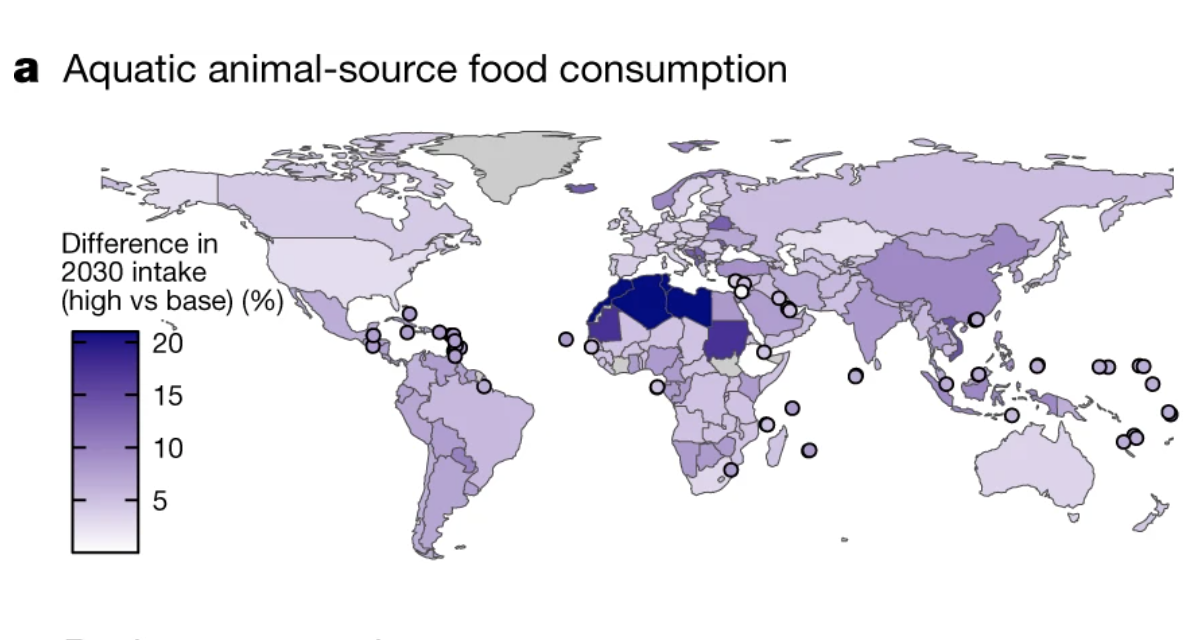Boosting global production of aquatic animal-based food sources by 15 million metric tons by 2030 would increase consumption while driving down prices by about 26 percent, reducing consumption of red and processed meats that can lead to diet-related health problems, according to a recent study published in the journal Nature.
That roughly 8 percent increase in production of wild-caught fisheries and aquaculture – the latter including familiar species of shrimp and shellfish and also seaweed, plants and species like sea cucumber – would also prevent about 166 million cases of “inadequate micronutrient intake” especially in malnourished children by expanding those food choices, the study says.
“This finding provides a broad evidentiary basis for policy makers and development stakeholders to capitalize on the potential of aquatic foods to reduce food and nutrition insecurity and tackle malnutrition in all its forms,” write Christopher D. Golden, J. Zachary Koehn and Shakuntala H. Thilsted in their paper, “Aquatic foods to nourish nations.”
The paper is one in a series developed out of the Blue Food Assessment, a joint initiative of the Stockholm Resilience Center at Stockholm University, the Center for Ocean Solutions and Center on Food Security and the Environment at Stanford University, and the nonprofit food security group EAT.
“Despite contributing to healthy diets for billions of people, aquatic foods are often undervalued as a nutritional solution because their diversity is often reduced to the protein and energy value of a single food type (‘seafood’ or ‘fish’),” the Nature authors noted.
“Globally, multiple forms of malnutrition continue to be important and universal. Among children under the age of five, 149 million (22 percent) are affected by stunting and 45 million by wasting. Among adults globally, 2.1 billion are overweight or obese,” according to the paper.
Vitamin A deficiency is believed prevalent among children in Africa and South Asia, while zinc if deficient for half of all children. While inadequate diet causes nutrient deficiencies leading to ill health and death, cardiovascular diseases – also driven by diet-related factors, are the leading cause of death globally, claiming 17.8 million lives in 2017.
The researchers used an integrated model accounting for both land-based and aquatic food production, seeking a sustainable way forward to boost production and evaluate the health impacts.
In combination, increasing the supply of aquatic foods along with reducing red and processed meats consumption “may lead to a reduced risk of hypertension, stroke, heart disease, diabetes, colorectal cancer and breast cancer,” the researchers say.
“Countries that are rapidly undergoing the nutrition transition (such as China, India, Philippines, Malaysia, Indonesia, Vietnam, South Korea, Mexico, Brazil, Peru, Chile, Nigeria, Russia, USA and Canada) are most likely to benefit from increases in AASF production, which could avert the trajectory of their populations towards harmful levels of meat consumption.”
The researchers suggested four broad approaches to further research and policy moves:
- In countries with high micronutrient deficiencies, strengthen supply chains and availability of aquatic foods by improving fisheries management; enhancing sustainable aquaculture; and building more equitable national and regional trade networks.
- Promote diversity of nutrient-rich aquatic foods in sustainable aquaculture systems; desig national food-based dietary guidelines; and for plan public-health interventions targeting nutritional deficiencies among vulnerable populations.
- Create incentives for improving access and affordability of aquatic foods in countries experiencing a rapid nutrition transition.
- Make aquatic foods a priority in social protection programs, including food assistance, school meal programs, and safety nets for the most nutritionally vulnerable, including pregnant and lactating women, young children in the first 1,000 days of life, and older people.
“With more than 1.5 billion people unable to afford a healthy and sustainable diet, our model results showcase the importance of price and economic policies in creating nutritious diets that are affordable for consumers,” the authors concluded. “These measures should enable aquatic foods to have an important role in nourishing the global population and improving global nutrition and health.”







